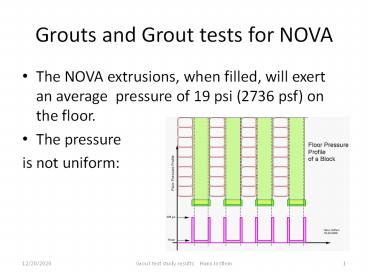Grouts and Grout tests for NOVA - PowerPoint PPT Presentation
Title:
Grouts and Grout tests for NOVA
Description:
... grouts Typical mix Test assembly Purpose of the Test Test Progress Slide 13 Slide 14 Slide 15 Slide 16 Floor Grouting (Far Detector only) ... – PowerPoint PPT presentation
Number of Views:154
Avg rating:3.0/5.0
Title: Grouts and Grout tests for NOVA
1
Grouts and Grout tests for NOVA
- The NOVA extrusions, when filled, will exert an
average pressure of 19 psi (2736 psf) on the
floor. - The pressure
- is not uniform
2
Floor pressure
- It is actually more complicated there is partial
force transmission through the webs, - Except for the middle channel in the end cap.
3
There are two locations where grout can even out
the pressure on the Extrusions
- Between the block and the pallet
- (applies to IPND as well)
- Between the pallet and the hall floor
- (Applies to far detector only)
4
Why do we need grout ?
- The PVC block is stiff
- We always assumed a full support area
- There are several sources of imperfect alignment
of the block components versus the pallet- or
floor shape
5
Geometrical Imperfections
- Non-square module bottoms (X and Y)
- Module bottoms misaligned (X and Y)
- Pallet construction tolerances
- Concrete floor not a perfect plane
- Cumulative error
- Somewhere between 1/16 and 1/8 (my own wild
guess) - Risk High Stress Points on the bottom glue
joint - may cause glue joint failure
6
Grout Requirements
- Long Service Life (no deterioration with time or
oil soaking) - No Creep (to avoid stresses during partial oil
filling) - Stiff (same reason)
- Easy to install
- Must flow easily
- Must provide very long pot life (Days ?)
- Must bear loads quickly (an hour or less ?)
- Does not require a tight seal to prevent leak-out
- Inexpensive (if possible)
7
Liquid Organic Grouts
- Commonly used for machinery
- Require leak-tight form
- Not easily used on far detector floor
- Load bearing setup time is much longer than the
pot life - Costly
8
Cement based grouts
- See DocDB 581 (January 2006) for measurements
- Last for decades (centuries ?)
- Do not require leak tight forms
- Have the marvelous property of being
- Tixotropic
- Behave like liquids when shaken or stirred
- Behave like solids when at rest
9
Typical mix
- Use play-sand as filler, add cement, mix
- Or, use premix, add water, and mix
- Fill into the gap
- vibrate with a long board until settled
- It can now bear the full load instantly
- Let cure (curing can be as short as 30 minutes,
and can be tuned with additive for a pot life
as long as 3 days)
10
Test assembly
11
Purpose of the Test
- Find out how hard or easy it is to fill the
mortar in a tall gap with realistic block shape - Check on resulting completeness and distribution
of fill - We covered the plywood wall with plastic foil to
separate it from the mortar
12
Test Progress
- Everything worked pretty well on first try,
- Except we tried to vibrate the mortar with a ¼
stick, which was too wimpy - On second try, used a 4 x 1/8 x 4 ft G10 strip,
- Which made the mortar flow perfectly
13
(No Transcript)
14
(No Transcript)
15
First try not quite perfect
16
Second tryperfect matching to the plywood/ foil
wall
17
Floor Grouting (Far Detector only)
- Place mortar on floor over the whole contact area
- Use a rake-type (maybe vibrating) tool to groove
it deeply - Set the block down with the block raiser
- During block alignment there is enough motion to
re-liquefy the grout - If not, just make a very small motion with the
block raiser and set the block down - Grout will set to full load bearing strength as
soon as the motion stops
18
Floor Grout Test
- In Lab F (thanks, John Voirin !) we set a stack
of three steel blocks on a grout bed - The three blocks exerts the same floor pressure
as the far detector - We tested freshly mixed grout and day-old grout
with Eucerin retarder mixed in - We covered floor and top of mortar with a PE
sheet for easy inspection and clean-up - We installed 4 dial gauges to measure distance
from floor to check for sagging
19
Sand mortar grout, shaped with a trowel
20
First block loaded onto grout bed, and equipped
with dial gauges
21
Three blocks loaded. Droop motion is less than
10 mil
22
Grout after 3-day loading Middle is raised,
matching bottom profile of the steel block
23
Grout with retarder, before loading
24
Grout after 3 days
25
Future
- Would like to use it on the mechanical prototype
of the INPD - Would like to use it on the FHEP (to test floor
grouting, mostly)
26
Reference
- For earlier detailed emasurements on grout
compressibility and load behavior see - NOVA Document 581-v1































